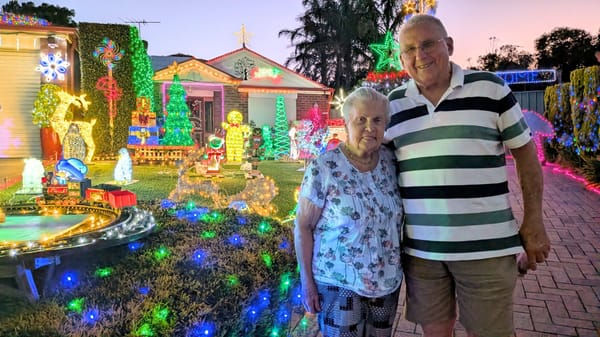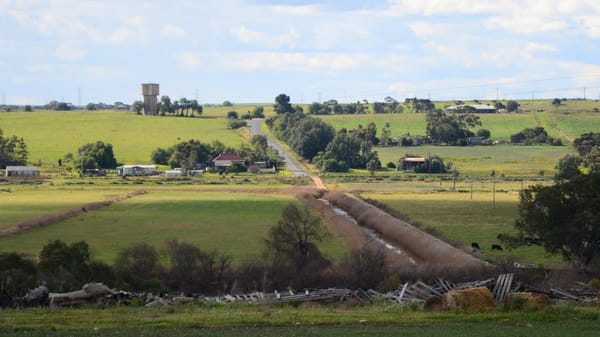Scars still run deep 50 years after Don Dunstan’s Monarto experiment
Monarto is generally remembered as a progressive premier's white elephant, but time hasn't healed old wounds for the families who were evicted from their farms in 1972.

This story was originally published behind Murray Bridge News’ paywall. Paywalled stories are unlocked four weeks after publication. Can’t wait that long? Subscribe here.

Robert Thiele first heard about it when he came home on what would have been the afternoon of March 29, 1972.
“I remember walking in from school and Mum said, ‘have you heard about it? There’s going to be a new city at Monarto’,” he said.
With Adelaide’s population growing, Premier Don Dunstan said a new satellite city would need to be built east of the Mount Lofty Ranges: Murray New Town, it was called at first.
The state government would acquire an area of 16,000 hectares.
In a single day, 50 years ago this week, a quiet farming community on the Murray plains had been changed forever.

Many of the first European settlers at Monarto were German, with family names like Schubert, Frahn, Bretag or Hartmann.
Murray Bridge Councillor Clem Schubert’s grandfather came out from Germany at the age of 18, and worked in a mill at Hahndorf and for the Jaensch family at Salem before taking up his own property at Monarto.
He rode through the scrub on horseback and cleared plenty of it with an axe himself.
“It was a wealthy area, socially speaking,” Mr Schubert said; there had been dances, sporting clubs, all the usual distractions for a young bloke in the 1960s.
Your word was your bond, and there’d hardly be a spare seat at the Zion Lutheran Church on Sundays.
They were hard workers at the old Monarto, Mr Thiele said: “you’d work your arse off six days a week, have church on Sunday, maybe go for a quick drive, then at six o’clock on Monday morning she’d go again”.
Every little farm had a few cows, a few pigs, a few chooks for eggs, a few sheep and some crops.
Not much rain would make it over the hills, but a bit would blow up from the lakes.
An SA Film Corporation short shot in 1975, which you can watch below, captured a parting glimpse of a community that was already disappearing.
“I only hope (the city) goes ahead, the way it looks it will,” a farmer tells the film crew.
“If it doesn’t, that’s when I’m going to be hurt: to be moved from my place for something that didn’t happen.
“That’s gonna really hit.”
An old dairyman suggests he’s unhappy at being asked to move, but he’s ready to retire anyway: “I’ve hit three score and 10, and now I want to see progress”.

Murray New Town: a utopia in the mallee scrub
Fifty years ago this week, on March 29, 1972, the office of Premier Don Dunstan put out a press release which began like this:
The South Australian Government will establish a major new city in the general Murray Bridge area to siphon off excess Adelaide metropolitan area population growth, the Premier and Minister of Development, Mr Dunstan, said today … The decision to develop a major city, with a population base of 100,000 – and perhaps increasing to 200,000 by the turn of the century – represented one of the most far-reaching moves since the founding of Elizabeth. Mr Dunstan said that projections of future population levels for Adelaide were alarming. By the turn of the century, Adelaide, on its present growth rate, would be about double its present size. The government was not prepared to accept this increase as inevitable.
The Murray New Town project was conceived at a time when Adelaide’s population had been growing at 3.3 per cent per year, and was forecast to reach 1.3 million before too long.
Mr Dunstan feared that South Australia’s capital would become smoggy and congested, with more and more people squashed into the gap between the Mount Lofty Ranges and the Gulf St Vincent.
The planned satellite city on the plains east of the ranges was meant to be an escape valve.
But South Australia’s progressive premier and the Department of Urban and Rural Planning soon began imagining it as a sort of utopia, somewhere they could put the latest theories of urban and social planning into practice.
“I said to Don one day, ‘Like Canberra, should Monarto have a lake?’” journalist Rex Jory later recalled in an interview with the Don Dunstan Foundation.
“I’m sure the thought had never crossed his bloody mind, but he said, ‘yes, it should, and we should have sailing ships and restaurants and...’ the whole thing, and off he went.
“You could almost hear his mind saying, ‘that’s a good idea, we could do this’.”

That same idealistic zeal shone through in speeches Mr Dunstan gave at the time.
Monarto would be a uniquely Australian city, he promised, more liveable than Canberra and more diverse than Elizabeth.
“Monarto will have a distinctive and lively city centre, homes to appeal to all income groups, abundant open-air recreational and park space and literally millions of trees,” he said when a concept plan was revealed in 1974.
“It won’t be a one-class or one-industry city.
“It will contain a variety of manufacturing, commercial, academic, scientific and government ventures; it will have a balanced, self-contained community.”

Rocky Gully Creek would be dammed close to the spot where Monarto Safari Park’s old visitor centre stands today, forming a lake on which would sit the new city’s central business district.
You would be able to eat lunch or ride a bike on the foreshore, or go and see a show in the theatre that would be built there.
Green corridors would run through the city – you could ride a horse right through it, the Premier boasted – and residents would never be more than a short walk away from the nearest park, school, shop or public transport route.
Perhaps there would be a monorail.
“In terms of social facilities, recreational facilities, ease of getting to and from work and actual living conditions, the residents of Monarto will be the most pampered urban dwellers in Australia,” Mr Dunstan told a Town and Country Planning Association lunch in 1974.
The federal government of Prime Minister Gough Whitlam gave $10 million worth of funding to the Monarto project, worth about $66 million in today’s dollars, as part of a wave of spending on new cities.
Some of those cities have since flourished, such as Albury-Wodonga, Bathurst, Orange and Geelong; others, like Monarto and Salvado, have been forgotten.
Two waves of Monarto residents have had their land taken
This was not the first time Monarto’s residents had been disposessed, of course.
The area got its name from Queen Monarto, a Ngarrindjeri or Ngaralte elder who lived in the area when the first European colonists arrived in 1847.
“Older settlers remembered with apparent glee that their families had hunted off the Aborigines from their land with stockwhips,” historian Robert Linn wrote more than a century later.
“White civilisation arrived with its crusading vigour.”

The descendants of the German, Scottish, Irish and English settlers did not have such a physically brutal experience; and they were financially compensated for their losses.
Nonetheless, Mr Thiele compared the Monarto Development Commission’s arrival to an ethnic cleansing operation.
The first properties the commission acquired had belonged to two farmers who had been struggling financially.
“Once they got those two acquired it was like a snowball effect,” he said.
“They moved in like the Russians in Ukraine at the moment: they cleansed the place, they knocked down buildings, the farmers had to immediately vacate ... it was like bringing the tanks in.”

They had been “ruthless bastards”, Mr Schubert argued.
Some locals had purchased properties elsewhere, subject to finance, only for the commission to turn around and offer them 75 per cent of the value they’d promised.
“They put you in such a position that, in the finish, you had to either sign off or you’d lose your deposit,” he said.
“Those were the underhanded tactics that mob used.”
Suddenly all of the men’s school friends and neighbours were packing up and moving to Victoria or some other far-flung spot.
“It simply gutted a very strong, close-knit community,” Mr Thiele said.
“There were no dances any more and all the sporting clubs closed because everyone left.”
Yet, within only a few years, it became clear that it had all been for nought.
Population projections were ‘hopelessly wrong’
It is ironic, in hindsight, that a government which wanted to increase Monarto’s population wound up driving so many people out of the district.
“There was obviously a gross over-estimate of the initial growth of Monarto,” Ray Bunker, a high-ranking official with the Department of Urban and Regional Development, later recalled.
“You only have to look at any new town experience in the UK, for example, to know that it takes a hell of a lot of time to get the first 10,000 people.
“There’s an enormous infrastructure investment that has to be made and, even when you’re talking about transferring jobs, it’s slow and complex.
“The Monarto projections were hopelessly out of kilter.”

Perhaps Dunstan had been trying to match his predecessor, Sir Thomas Playford, whose founding of Elizabeth had been one of his crowing achievements.
But by 1974 it became clear that the baby boom had ended, and that the new contraceptive pill had significantly reduced population growth.
That, in turn, meant there was no need to build a new city on the plains.
Federal funding for the Monarto project dried up after Mr Whitlam was replaced as Prime Minister by Liberal Malcolm Fraser in 1975.
Ray Taylor, the chairman of the Monarto Development Commission, resigned barely two years after his appointment and was not replaced.
Just like that, Don Dunstan’s vision faded into the haze over the paddocks, leaving behind a broken community.
Mr Schubert’s family moved onto an 800-acre property at Pallamana, where he and his wife still live to this day.
His father never spoke much about what the family had lost, “but Mum, til her last breath I don’t think she ever forgot it,” he said.
“It was her home.”

What’s the moral of the story?
Asked what lesson they took out of the whole episode, the two old farmers paused a moment.
“The scale was far too big,” Mr Thiele suggested at last.
“There was not enough preparation.
“It would have been good if, before it was on TV, they had a public meeting with people: grab 10 or 20 local representatives, say ‘hey guys, we’re thinking of putting a city here’.”
Even then, Mr Schubert guessed, things would have played out differently if the same kind of idea had been proposed in the 2020s instead of the 1970s.
For one thing, individual farmers might not have focused so closely on how they could escape without losing too much money.
“The local community, I guess, I don’t think they trusted each other enough or were prepared to work together to get a better outcome,” he said.
The whole affair has had one silver lining, of course: the land earmarked for Monarto’s CBD was taken over by the Royal Zoological Society of South Australia and became the world-renowned Monarto Safari Park.
But time won’t heal old wounds for the generation who lived through the upheaval of a lifetime.
“It was a proud area,” Mr Schubert said.
“But in the end it was taken away and lost.”





